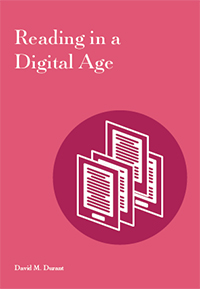
Reading in a Digital Age
Skip other details (including permanent urls, DOI, citation information): This work is licensed under a Creative Commons Attribution-NonCommercial-NoDerivatives 4.0 International License. Please contact [email protected] to use this work in a way not covered by the license.
For more information, read Michigan Publishing's access and usage policy.
What the Research Tells Us
How, then, is one to unravel the conflicting claims regarding the benefits of reading in print format versus digital format? One obvious starting place is by looking at the various studies that have been done comparing reading the printed page to reading on digital devices. We’ve already mentioned a few earlier, but the number of such projects has grown tremendously as this topic has become a source of controversy.
On the one hand, a number of research studies have appeared that describe little or no difference between reading on screens and reading on paper. For example, in 2010, usability expert Jakob Nielsen did a study comparing reading speed and comprehension for a printed book, iPad, Kindle, and PC. The study found that users read somewhat faster in print, while comprehension was similar regardless of platform. User satisfaction levels were comparable for the print book, Kindle, and iPad.[54]
A 2011 study by Johannes Gutenberg University in Germany used eye tracking and EEG readings of more than fifty subjects, a mix of young adults and senior citizens, to compare the mental effort required to read from a print book, an e-reader, and a tablet. What they found was that there was no real difference between the three formats in terms of comprehension or effort expended. As the researchers put it in the 2013 article describing their study, “The present findings provide no evidence to support the assumption that online reading effort increases when people read on digital devices as opposed to paper.”[55] One really interesting part about the Gutenberg University study is that, according to the researchers, “both younger and older Participants showed an overwhelming preference for the book page when asked to choose their preferred reading medium.” However, “though participants stated that they preferred the book page over the electronic reading devices, none of the quantitative online measures collected support that reading was more effortful for the digital media.”[56] The authors offer the following explanation, one very much in keeping with the preexisting cultural prejudices theory favored by Thompson and Jones: “This suggests that the overwhelming public opinion that digital reading media, though convenient, reduce the pleasure of reading is a cultural rather than a cognitive phenomenon. From this perspective, the subjective ratings of our participants (and those in previous studies) may be viewed as attitudes within a period of cultural change.”[57]
There have been several other studies that have also found no real difference in comprehension between reading from a print codex and a digital device. Most notably, a study published in 2013 by Sara Margolin, a professor of psychology at the College at Brockport, State University of New York, analyzed reading comprehension among ninety undergraduates, of whom a third read ten short passages on paper, a third the same passages on a computer, and the final third on a Kindle. According to Margolin and her coauthors, “The results indicated no significant differences among media presentation types. This lack of significant differences in comprehension accuracy across media platforms indicates that if comprehension differences exist, the present research did not find them and therefore are likely to be very small differences or at least moderated by some other factor.”[58]
While some studies reinforce the idea that there is no inherent difference in print versus screen-based reading, and thus whatever differences exist are the result of ingrained cultural practices, others support the arguments of digital skeptics. Most prominent in this regard has been the work of Norwegian researcher Anne Mangen. Mangen, who works at Stavanger University in her native Norway, has done extensive work comparing print versus digital reading. In one study published in 2013, Mangen and two colleagues worked with a group of seventy-two Norwegian tenth graders. Half of these students read two texts in print format and the other half read the same two texts in PDF format on a computer. Both groups were tested afterward on comprehension. Mangen and her colleagues found that “subjects who read the texts on paper performed significantly better than subjects who read the texts on the computer screen.”[59]
Mangen and her colleagues have followed up this study with another as-yet-unpublished one. This latter project used a similar methodology to the previous one. A group of fifty readers were asked to read a twenty-eight-page story by Elizabeth George, half in paperback and half on a Kindle. The results, released by Mangen at a July 2014 conference in Italy, revealed that the Kindle readers did significantly worse when tested about the plot of the story. The British newspaper The Guardian quoted Mangen discussing her findings:
When you read on paper you can sense with your fingers a pile of pages on the left growing, and shrinking on the right. . . . You have the tactile sense of progress, in addition to the visual. [The differences for Kindle readers] might have something to do with the fact that the fixity of a text on paper, and this very gradual unfolding of paper as you progress through a story, is some kind of sensory offload, supporting the visual sense of progress when you’re reading. Perhaps this somehow aids the reader, providing more fixity and solidity to the reader’s sense of unfolding and progress of the text, and hence the story.[60]
According to the article, Mangen’s research has left her very much concerned about the impact of screen-based reading on our ability to engage in deep linear reading.[61] So a look at the available research studies on print versus digital reading reveals that some refute the arguments of the digital skeptics, while others support them. After all this, we are right back where we started. One of these sets of studies must be wrong; they can’t both be right, can they? Surely someone has raised legitimate questions regarding at least some of these studies?
There have, in fact, been commentators who have cautioned us against drawing sweeping conclusions from what are relatively limited studies. Hayles, in discussing Carr’s The Shallows, argues that “although Carr’s book is replete with many different kinds of studies, we should be cautious about taking his conclusions at face value.”[62] As Jeremy Greenfield of Forbes pointed out, only two of the students in Mangen’s Elizabeth George study had used Kindles before, while all of her students were undoubtedly quite familiar with print, thus possibly skewing the results. (In all fairness, Mangen and her coauthors noted this themselves in their article.)
Greenfield noted that this might indicate a broader problem with studies that suggest major differences in how people read digital text as opposed to how they read from paper: “Experiments have been conducted for decades comparing reading on screens versus reading in print. Early results suggested very strongly that print had massive advantages. But as time went on, screen reading drew closer to print reading. One theory is that test subjects were more used to the medium as more people read on screens, and that this changed the findings. E-reading is such a new technology, and most of the research subjects part of the digital group were unfamiliar with it and with the Kindle device, as opposed to reading in print, which nobody is unfamiliar with.”[63]
So perhaps Bilton, Thompson, and Jones are correct that there is no fundamental difference between print and screen-based reading. Perhaps the studies to the contrary simply are the result of user unfamiliarity with the technology, cultural prejudices in favor of print, and flaws with current e-reading technology that will eventually be corrected. Unfortunately, there are also limitations to the studies that are supportive of digital reading that should be pointed out as well.
For example, both the Gutenberg University and Margolin studies involved short pieces of text. The readings in the latter were about five hundred words; in the German study, fewer than three hundred. One must wonder what the results would have been had the subjects been required to read five thousand words, let alone fifty thousand. Would the comprehension scores still have been similar? In addition, one of the main concerns regarding digital reading is that much of it is done on multipurpose devices, such as tablets and smartphones, which offer numerous diversions more immediately stimulating than immersing yourself in a text. Again, how would the subjects in studies such as Margolin’s and Gutenberg University’s have fared had they not been reading in a controlled environment? Would they have been as diligent and able to avoid distraction if they hadn’t been essentially a captive audience with graduate assistants looking over their shoulders or electrodes attached to their heads?
So if the scientific research on each side of the debate has its limits, where are we to turn? Fortunately, there are other forms of empirical evidence that we can use to get a sense of this issue. In this case, we can rely on what readers themselves have to say about whether they prefer print or digital and look at publishing sales and usage figures as well as user preference surveys.


